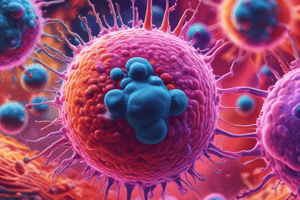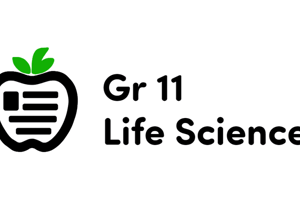Podcast
Questions and Answers
What is the primary function of vaccines?
What is the primary function of vaccines?
- Causing diseases
- Destroying bacteria
- Stimulating the immune system (correct)
- Treating infections
Which type of cells produce antibodies tailored to specific pathogens?
Which type of cells produce antibodies tailored to specific pathogens?
- Macrophages
- Helper T-cells
- B-Lymphocytes (correct)
- Killer T-cells
What do phagocytes like macrophages do during an immune response?
What do phagocytes like macrophages do during an immune response?
- Initiate inflammation
- Produce antigens
- Release antibodies
- Identify and engulf pathogens (correct)
What is the main purpose of antibiotics?
What is the main purpose of antibiotics?
Which line of defense in plants includes chemical defenses like salicylic acid?
Which line of defense in plants includes chemical defenses like salicylic acid?
Which type of immunity involves specialized responses mediated by lymphocytes and antibodies?
Which type of immunity involves specialized responses mediated by lymphocytes and antibodies?
What is the role of killer T-cells in the immune response?
What is the role of killer T-cells in the immune response?
What do animals rely on as the body's initial defense against pathogens?
What do animals rely on as the body's initial defense against pathogens?
Which type of cells are the key players in immunity?
Which type of cells are the key players in immunity?
What is the primary function of lymphocytes?
What is the primary function of lymphocytes?
What are the organelles containing digestive enzymes that break down bacterial or viral cell walls?
What are the organelles containing digestive enzymes that break down bacterial or viral cell walls?
What is the process by which cells engulf and digest foreign particles?
What is the process by which cells engulf and digest foreign particles?
What are the complex molecules that trigger immune reactions?
What are the complex molecules that trigger immune reactions?
What are the specialized proteins designed to neutralize specific invaders?
What are the specialized proteins designed to neutralize specific invaders?
What is the primary function of antibodies?
What is the primary function of antibodies?
Which of the following is NOT a tissue where lymphocytes can be found?
Which of the following is NOT a tissue where lymphocytes can be found?
What is the term for the immune system's ability to ward off invaders and maintain health?
What is the term for the immune system's ability to ward off invaders and maintain health?
What are the cells that recognize and engulf pathogens?
What are the cells that recognize and engulf pathogens?
Flashcards are hidden until you start studying
Study Notes
Vaccine and Antibiotic
- Vaccines are biological preparations made from weakened or fragmented pathogens that stimulate the immune system to produce antibodies, providing long-lasting protection against specific diseases.
- Antibiotics are medicines derived from living organisms like bacteria or fungi, used to treat infections caused by bacteria or fungi.
Plant Immunity
- Plants have a dual-line defense mechanism against invading microorganisms, consisting of physical barriers and chemical defenses.
- The first line of defense includes physical barriers like the waxy cuticle and bark, alongside chemical defenses like resins and gums produced upon injury.
- Upon infection, plants activate a second line of defense, releasing chemical compounds like salicylic acid to trigger systemic responses and fortify unaffected cells against pathogens.
Animal Immunity
- Animals exhibit both innate and acquired immunity.
- The innate immune system serves as the body's initial defense, comprising physical barriers and non-specific responses like inflammation and fever.
- Acquired immunity, developed following exposure to pathogens, involves specialized responses mediated by lymphocytes and antibodies.
Lymphocytes in Immune Response
- B-lymphocytes recognize antigens and produce antibodies tailored to bind with and neutralize specific pathogens.
- Upon subsequent exposure to the same pathogen, B-lymphocytes mount a rapid response, conferring natural immunity.
- T-lymphocytes, including killer T-cells and helper T-cells, play a crucial role in immune responses.
- Killer T-cells target and destroy virus-infected or parasite-infected cells, while helper T-cells initiate and coordinate immune responses.
Phagocytes in Immune Response
- Macrophages, a type of phagocytic cell, play a critical role in identifying and engulfing invading pathogens through phagocytosis.
- Phagocytosis involves the formation of pseudopodia around pathogens, which are then enclosed within vacuoles and digested by lysosomal enzymes.
Vaccinations
- Vaccinations represent a cornerstone of modern medicine, harnessing the body's immune system to confer protection against infectious diseases.
- By administering vaccines containing weakened or fragmented pathogens, the immune system is primed to recognize and respond to future encounters with the same pathogen, establishing long-term immunity.
Immunity
- Immunity is nature's defense mechanism, enabling plants and animals to combat infections and safeguard their well-being.
- The immune system plays a pivotal role in the intricate dance between hosts and pathogens, orchestrating responses to ward off invaders and maintain health.
Lymphocyte and Key Terminology
- Lymphocytes are a type of white blood cell found in various tissues like the tonsils, lymph glands, spleen, and bloodstream, acting as sentinels to patrol the body and mount responses against invading pathogens.
- Antigens are complex molecules that trigger immune reactions, and antibodies are specialized proteins designed to neutralize specific invaders.
- Phagocytosis is the process by which cells engulf and digest foreign particles, a crucial aspect of innate immunity.
- Lysosomes are organelles containing digestive enzymes that break down bacterial or viral cell walls.
Studying That Suits You
Use AI to generate personalized quizzes and flashcards to suit your learning preferences.



